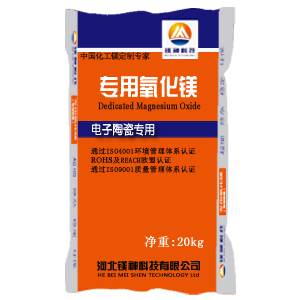
Today, a professional magnesium oxide manufacturer talks about the magnesium oxide for electronic ceramics with you. Generally speaking, the electronic ceramics selects oxide ceramics. Because magnesium oxide has larger surface activity and high temperature characteristic, magnesium oxide is the main raw material in the oxide ceramics. In the research and development of high pure magnesium oxide ceramic material with high dense, MgO has its own characters. Adopting 99% or higher purity magnesium oxide as raw material, it can assure the purity of magnesium oxide ceramic.
As an important inorganic chemical product, magnesium oxide has broad applications. It is mainly used for refractory matter and refining magnesium metal. Next, it can be used for paper pulp, adsorbing uranium, building materials, fertilizer, rubber, plastic, adhesive and so on. Various countries in the world are researching and developing nano magnesium oxide powder. Since the nineteen-eighties, the nano magnesium oxide product had been put forward. Taking magnesium metal as raw material, Meishen adopts gas-phase oxidation technology to develop nano magnesium oxide. This nano magnesium oxide’s purity is more than 99.95%, and mean grain size is 10nm. In the aspect of applications, this nano magnesium oxide can be used for transparent thin ceramic with excellent tenacity. The heat-resistance temperature can achieve 2800℃. At present, Meishen has provided sample for aviation, electronic engineering, optical element for other industries.
On this basis, as a professional magnesium oxide supplier, Meishen Technology pays more attention to the scientific and technological innovation. Cooperating with customers, at the same time, Meishen selects better magnesium oxide powder as raw material. The mean grain size of this powder is between 0.01µm to 10µm, and the purity is more than 99.5%. In the raw material, Meishen adds superfine magnesium oxide powder. The mean grain size is between 0.5µm and 1.5µm. Because of the larger surface, the melting point of superfine powder decreased. Therefore, after adding superfine powder, it can sinter at lower temperature.